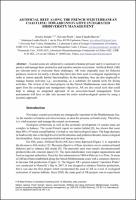Chapter Artificial reef along theFrench Mediterranean coastline: toward innovative integrated biodiversity management
| dc.contributor.author | Salaün, Jessica | |
| dc.contributor.author | Pioch, Sylvain | |
| dc.contributor.author | Dauvin, Jean-Claude | |
| dc.date.accessioned | 2022-06-01T12:12:50Z | |
| dc.date.available | 2022-06-01T12:12:50Z | |
| dc.date.issued | 2020 | |
| dc.identifier | ONIX_20220601_9788855181471_253 | |
| dc.identifier.issn | 2704-5846 | |
| dc.identifier.uri | https://library.oapen.org/handle/20.500.12657/56070 | |
| dc.description.abstract | Coastal zones are subjected to human pressure and it is necessary to protect and manage these productive and sensitive ecosystems. Artificial Reefs (AR) are relevant tools to overcome these challenges. For nearly a decade they have been used in ecological engineering in order to restore specific habitat functionalities. In the meantime, they are also employed to manage human activities. The review of the latest projects on the French Mediterranean coast shows that apart from the ecological objectives, AR are also social tools that could help to enlarge an integrated approach of an ecosystem. | |
| dc.language | English | |
| dc.relation.ispartofseries | Proceedings e report | |
| dc.subject.other | Artificial Reefs | |
| dc.subject.other | Ecology | |
| dc.subject.other | Management | |
| dc.title | Chapter Artificial reef along theFrench Mediterranean coastline: toward innovative integrated biodiversity management | |
| dc.type | chapter | |
| oapen.identifier.doi | 10.36253/978-88-5518-147-1.31 | |
| oapen.relation.isPublishedBy | bf65d21a-78e5-4ba2-983a-dbfa90962870 | |
| oapen.relation.isbn | 9788855181471 | |
| oapen.series.number | 126 | |
| oapen.pages | 7 | |
| oapen.place.publication | Florence |

